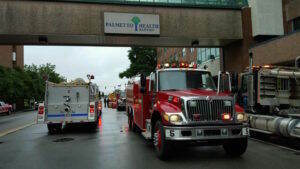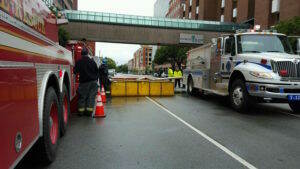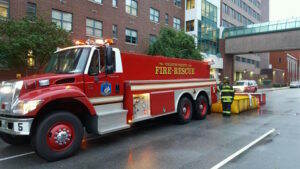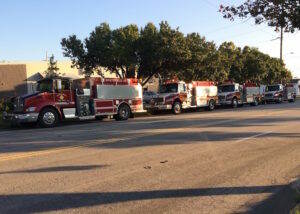January 27, 2016
The tension generated between life in rural/country small town settings and life within big cities has long been a theme of literature and was often noted among agents of romanticism, rationalism, and classicism. Delivered in stage plays and poetry by literary greats such as Shakespeare, Wordsworth, and Hawthorne or portrayed in novels and television shows, the rugged individualism of country life is contrasted with the roles of corporate life in the city. Even music themes touch on the subject. Who can forget Dirks Bentley’s, “Home” or “Small Town” by John Anderson pointing up the conflicts. Mixing fire service personnel and resources from rural settings with those of cities is thought to be problematic as skills, knowledge, and abilities are considered to be different. Columbia FD Captain Steve Perry honestly assessed “we were very apprehensive at first” and of his personnel, Glassy Mountain Fire Chief Robert Staples said, "I believe Chris and David had no idea what exactly they were going to do, they just wanted to help.” But by the time units and firefighters were released to return home, Columbia FD Captain Kelvin Patterson summed it appropriately, “the guys came in and blended so well." When floodwaters affected Columbia, impacting the city’s water intake plant, the delivery of water for fire protection and fresh, potable water for human consumption was compromised. A call for outside help in the form of mobile water delivery assets was placed through the Division of Fire & Life Safety Mobilization Team. Within hours of the request, firefighters and fire apparatus from the rural settings across South Carolina were on their way to Columbia.
To the South Carolina fire service, these assets are normally called tankers (west of the Mississippi River they are known as tenders) and they transport and offload water during firefighting operations. Depending on the type of truck, number of axles, and tank configuration, the amount of water carried by these units can range from 1000 to over 8000 gallons.
These tankers are usually filled from hydrants on a pressurized municipal water delivery system or occasionally from gravity fed above ground tanks. In the absence of a pressurized water system, the tankers can be filled through the use of a “dry hydrant." This type of hydrant consists of a system of piping installed in lakes, ponds, and flowing streams from which water can be extracted by suction. Water is withdrawn through the dry hydrant and pumped to the fire or as in this scenario pumped in the tanker and hauled to the fire location.
When floodwaters affected Columbia, impacting the city’s water intake plant, the delivery of water for fire protection and fresh, potable water for human consumption was compromised. A call for outside help in the form of mobile water delivery assets was placed through the Division of Fire & Life Safety Mobilization Team. Within hours of the request, firefighters and fire apparatus from the rural settings across South Carolina were on their way to Columbia.
To the South Carolina fire service, these assets are normally called tankers (west of the Mississippi River they are known as tenders) and they transport and offload water during firefighting operations. Depending on the type of truck, number of axles, and tank configuration, the amount of water carried by these units can range from 1000 to over 8000 gallons.
These tankers are usually filled from hydrants on a pressurized municipal water delivery system or occasionally from gravity fed above ground tanks. In the absence of a pressurized water system, the tankers can be filled through the use of a “dry hydrant." This type of hydrant consists of a system of piping installed in lakes, ponds, and flowing streams from which water can be extracted by suction. Water is withdrawn through the dry hydrant and pumped to the fire or as in this scenario pumped in the tanker and hauled to the fire location.
 Upon arriving at the fire location, tankers off-load the water they are carrying into large, above ground portable tanks by gravity or by pump-assisted dumping. The above ground tanks ranging in size from 500 to 5000 gallons are normally constructed of a folding support frame and a pliable watertight material. From this tank, the water is extracted by suction into the firefighting pump and applied to the fire.
With most areas of our state being outside the boundaries of a municipal water delivery system, rural firefighters routinely practice and are called upon to transport through the use of tankers the water needed for fire protection. Multiple tankers are placed into operation in a process known as shuttling from the fill site (pond, lake, or pressurized hydrant) to the dumpsite (fire location) in order to maintain a continuous flow of water available for firefighting operations. It is this shuttling action for which rural firefighters are intimately familiar and is exactly why they were needed in Columbia.
According to data from Chad Beam, SC Department of Labor, Licensing, and Regulation, Division of Fire and Life Safety, who acted as Branch Chief of Emergency Response for the flood event, 36 tankers responded to Columbia. Among these tankers was one from Glassy Mountain Fire Department (GMFD) in upper Greenville County and another from the Whitefield Volunteer Fire Department (WFD) in Anderson County.
Robert Staples, GMFD Chief, indicated he “was glad that we were able to help” and noted “the upstate is rich in resources and many of them were called upon…”. Chief Cromer with WFD himself was among eight other members of his department who worked in Columbia. Noting that they “each worked 48-hour shifts at several stations throughout Columbia during the mobilization."
Upon arriving at the fire location, tankers off-load the water they are carrying into large, above ground portable tanks by gravity or by pump-assisted dumping. The above ground tanks ranging in size from 500 to 5000 gallons are normally constructed of a folding support frame and a pliable watertight material. From this tank, the water is extracted by suction into the firefighting pump and applied to the fire.
With most areas of our state being outside the boundaries of a municipal water delivery system, rural firefighters routinely practice and are called upon to transport through the use of tankers the water needed for fire protection. Multiple tankers are placed into operation in a process known as shuttling from the fill site (pond, lake, or pressurized hydrant) to the dumpsite (fire location) in order to maintain a continuous flow of water available for firefighting operations. It is this shuttling action for which rural firefighters are intimately familiar and is exactly why they were needed in Columbia.
According to data from Chad Beam, SC Department of Labor, Licensing, and Regulation, Division of Fire and Life Safety, who acted as Branch Chief of Emergency Response for the flood event, 36 tankers responded to Columbia. Among these tankers was one from Glassy Mountain Fire Department (GMFD) in upper Greenville County and another from the Whitefield Volunteer Fire Department (WFD) in Anderson County.
Robert Staples, GMFD Chief, indicated he “was glad that we were able to help” and noted “the upstate is rich in resources and many of them were called upon…”. Chief Cromer with WFD himself was among eight other members of his department who worked in Columbia. Noting that they “each worked 48-hour shifts at several stations throughout Columbia during the mobilization."
 Initially crews were detailed for delivering water to Palmetto Health Center in Columbia, the only level one trauma center in the Midlands. Chief Staples stated his personnel “shuttled 15-18 tanks of water as part of a group that resupplied the hospital’s on premises storage tanks and HVAC system.” The crews from WFD over the course of a 16-hour operational period “shuttled over 34,000 gallons of water to support the operation” according to Chief Cromer.
As conditions for maintaining the potable water supply at the hospital began to normalize with the arrival of military assets, tanker crews then began assisting Columbia fire crews with local firefighting responses. Columbia Captain Steve Perry noted, “When their 12 hour shift was up, we asked they stay with us, and they got to know neighboring stations in the 12 hours they were there.”
Initially crews were detailed for delivering water to Palmetto Health Center in Columbia, the only level one trauma center in the Midlands. Chief Staples stated his personnel “shuttled 15-18 tanks of water as part of a group that resupplied the hospital’s on premises storage tanks and HVAC system.” The crews from WFD over the course of a 16-hour operational period “shuttled over 34,000 gallons of water to support the operation” according to Chief Cromer.
As conditions for maintaining the potable water supply at the hospital began to normalize with the arrival of military assets, tanker crews then began assisting Columbia fire crews with local firefighting responses. Columbia Captain Steve Perry noted, “When their 12 hour shift was up, we asked they stay with us, and they got to know neighboring stations in the 12 hours they were there.”
 Chase Rapien, Whitefield FD, and another firefighter were stationed in Columbia from October 9th until late on the 11th. Chase stated that during this time they responded with Columbia Engine 11. Chase said it “was interesting and fun working with a new department seeing how they operate and handle their calls.” He was impressed with how the residents of the communities came together and showing their support for all the firefighters. Not knowing the Whitefield FD crews were from out of the area, Chase wrote he believed he “had more thanks and waves in that 2-3 days there that I have the entire 12 years of volunteering.”
Chief Staples said he “was pleased Glassy Mountain was able to provide some assistance even though we are mostly a volunteer department.” Chief Cromer expressed that his personnel “stepped up and volunteered to take time from their work and families…and that it was an honor for our volunteer department to be able to support the operation…”
And the learning curve was beneficial for all of the agencies involved. Columbia Captain Perry said, “speaking with the guys, they wanted to learn so much. After he and his crew “got them up to speed on our policies, it was great. I cannot speak high enough of these two men and their FD they represent. We rode each other’s trucks, to understand and appreciate each other more.”
With their efforts in delivering water complete for the time, the outside agencies returned home. Speaking of the Columbia crews, Chief Cromer said “it was obvious that they were relieved to have the extra support and manpower for one of the toughest weeks they will likely encounter in their careers…” Columbia Captain Patterson noted, “We had a great time and were honored that they took the time to help us. It goes to show you that firefighters are firefighters no matter where we are. I can't thank them enough.”
Any perceived disagreements disappeared during the 2015 South Carolina floods as resources and personnel from mostly rural, urban departments operated alongside their city counterparts in Columbia and in other areas across our state.
Answering the Sound of Sirens, responders personally and professional exemplified the highest and purest form of our brother and sisterhood. Firefighters demonstrated their creed of universal good will toward all men and portrayed the fraternal bond and firefighters the world over.
Country came to Columbia.
Chase Rapien, Whitefield FD, and another firefighter were stationed in Columbia from October 9th until late on the 11th. Chase stated that during this time they responded with Columbia Engine 11. Chase said it “was interesting and fun working with a new department seeing how they operate and handle their calls.” He was impressed with how the residents of the communities came together and showing their support for all the firefighters. Not knowing the Whitefield FD crews were from out of the area, Chase wrote he believed he “had more thanks and waves in that 2-3 days there that I have the entire 12 years of volunteering.”
Chief Staples said he “was pleased Glassy Mountain was able to provide some assistance even though we are mostly a volunteer department.” Chief Cromer expressed that his personnel “stepped up and volunteered to take time from their work and families…and that it was an honor for our volunteer department to be able to support the operation…”
And the learning curve was beneficial for all of the agencies involved. Columbia Captain Perry said, “speaking with the guys, they wanted to learn so much. After he and his crew “got them up to speed on our policies, it was great. I cannot speak high enough of these two men and their FD they represent. We rode each other’s trucks, to understand and appreciate each other more.”
With their efforts in delivering water complete for the time, the outside agencies returned home. Speaking of the Columbia crews, Chief Cromer said “it was obvious that they were relieved to have the extra support and manpower for one of the toughest weeks they will likely encounter in their careers…” Columbia Captain Patterson noted, “We had a great time and were honored that they took the time to help us. It goes to show you that firefighters are firefighters no matter where we are. I can't thank them enough.”
Any perceived disagreements disappeared during the 2015 South Carolina floods as resources and personnel from mostly rural, urban departments operated alongside their city counterparts in Columbia and in other areas across our state.
Answering the Sound of Sirens, responders personally and professional exemplified the highest and purest form of our brother and sisterhood. Firefighters demonstrated their creed of universal good will toward all men and portrayed the fraternal bond and firefighters the world over.
Country came to Columbia.
 Back to Firewire
Next Post
Back to Firewire
Next Post
